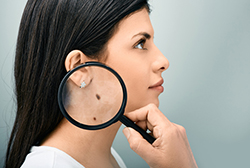
Ultimate Guide To Hair Loss Prevention
It is absolutely possible to have a full head of hair well into your 50’s and 60’s, even if genetics are not on your side. Experiencing hair loss can be different for everyone, and if you prefer to prevent it, there are steps you can take to help preserve your hair. To prevent hair loss, it is important to understand what may be causing it. This guide will help you understand all hair loss prevention options available to you!
Hair Strands Life Cycle
Below the scalp, there are thousands of follicles. Follicles are a tiny group of cells with a cavity in which the hair strand grows. The life cycle of a hair strand contains 3 phases:
- Anagen – The growth phase
- Catagen – The in-between phase
- Telogen – The falling Out phase
Every 30 days or so the hair strand will grow approximately a half an inch. This will continue for 2 to 6 years before falling out. It is very normal for individuals to lose hair strands each day. The problem begins when hair loss exceeds the development of new hair.
Causes Of Hair Loss
There are many reasons why you may be suffering from hair loss. Here is just some that you may want to take into consideration.
- Hormonal Changes – One of the leading causes of hair loss is when there is a conversion of testosterone into DHT or dihydrotestosterone. When this occurs, hair follicles are attacked causing a decrease in the production of new hair. As a result, flimsier hair strands are developed until follicles completely quit producing hair.
- Genetics – Baldness is hereditary. If there is a history of baldness on both sides of your family, then you have an increased chance of experiencing hair loss. Out of all the causes surrounding hair loss, this one cannot be avoided.
- Cancer Treatments – Chemotherapy and radiation can cause hair loss. However, it is normal for hair to grow back once these treatments are complete.
- Health Issues – Chronic illnesses can cause hair loss. This may include prolonged infections, thyroid gland disorders, skin disease, Lupus or diabetes. When your immune system is down, your body can experience stress which will trigger hair loss.
- Smoking – There is a lot of supporting evidence that proves smoking can have negative effects on hair growth.
- Drugs and Medications – There are some types of drugs that can increase the loss of hair. These include depression medications, high blood pressure meds, thyroid medications, oral contraceptives, warfarin, and heparin.
- Chemicals and Hair Treatments – Some chemicals can cause an increased chance of hair loss, such as hair dyes and bleaches. Things such as flat irons and ceramic curlers can also cause irreversible damage to your hair. Tight braids or excessive use of hair rollers can weaken the roots of your hair.
Different Types Of Hair Loss
There are several different types of hair loss. The scientific term for excessive hair loss is Alopecia. Here are just some of the most common types of alopecia.
Androgenetic Alopecia Or Male Pattern Baldness The main cause of hair loss in men is Androgenetic Alopecia. This type of hair loss is heavily caused by genetics and DHT. It begins on the forehead and will affect the entire top of the head. Most men who suffer from Androgenetic Alopecia end up losing a significant amount of hair around their heads.
Female Pattern Baldness Once a woman hits the menopausal stage, her chances of hair loss increase. The main difference between male and female baldness is hair loss for a woman occurs all over the scalp. Causing patches of bald spots in different places rather than starting at the forehead.
Alopecia Areata Alopecia Areata occurs when an individual is suffering from an autoimmune disorder. It is triggered by a virus, causing the white blood cells to attack the hair follicles. This can lead to an increase in hair loss and reduce the chances of hair regrowth. There are two types:
- Alopecia Totalis – Cause you to lose all the hair on your scalp.
- Alopecia Universalis – Not only does it cause you to lose all the hair on your scalp but also all over your body.
Scarring Alopecia This type of alopecia occurs when the scalp experiences trauma. This may include a burn, injury, a bacterial or fungal infection. The hair follicle becomes damaged, which results in scarring. Hair will not grow back in these scarred areas.
Telogen Effluvium Once the hair strands reach its last phase of the life cycle, it is known as Telogen. Also referred to as the resting phase. Telogen Effluvium occurs when excessive hair loss will not allow the hair follicles to keep up with growth. There are two different types:
- Acute Telogen Effluvium – Can last for up to 6 months.
- Chronic Telogen Effluvium – Can remain for years.
Telogen Effluvium can disappear without any type of treatment, but it may also require a medication called Minoxidil to help enhance the formation of new hair.
The Hair Shaft Defect Not as common as other types of hair loss, it is connected to a genetic disorder. A person with this defect is born with little to no hair, and the hair they do have is frail. This illness causes damage to the hair shaft. The three main types of hair shaft defects include pili torti, monilethrix, and trichothiodystrophy.
Trichotillomania Trichotillomania is more of a psychological than a physiological disorder. This is where a person will physically pull out their hair. It is a belief that instability in serotonin and dopamine levels within the brain can cause Trichotillomania.
Medication Treatments To Prevent And Cure Hair Loss
There are no cures that can completely treat baldness for good. With advancements in technology, however, medications can minimize hair loss and can help prevent total baldness. There are currently two medications on the market that are formulated to prevent and reduce hair loss that the FDA has approved. These include:
- Minoxidil (Rogaine) – Can be bought over the counter. It comes in liquid form and easy to apply to the scalp two times a day. It stimulates hair follicles, boosts hair growth, increases thickness and delays Telogen.
- Finasteride (Propecia) – Oral medication in the form of a pill. It helps deter DHT from being produced by the body. Used mainly by men, as it is not effective for women. It can reduce hair loss, as well as stimulate new hair growth.
- Corticosteroids – Used for a number of other medical conditions, corticosteroids come in injections, pills, and creams. It will stimulate hair growth and can see results within four weeks of beginning treatment.
- Anthralin (Drithocreme) – Available in topical cream form, and used to treat Alopecia Areata. Apply directly to the scalp and then rinse it off. Stimulated hair growth by 25 percent and results are seen within 6 months.
For these medications to work effectively, they will need to be taken continuously or at least until hair growth is regained. If medication is stopped, the excessive hair loss will return. Other medications that have been used include.
At-Home Remedies
Many different methods can help stimulate hair growth. Things such as proper nutrition, reduction of stress and proper exercise can all help. There are alternative methods that may be worth trying, but none of them give you the results that clinical treatments can.
Hairmax Lasercomb
Hairmax LaserComb is a non-surgical and non-medical hair loss treatment. It has been approved by the FDA. You will need to hold a device over the scalp for about 15 minutes during each session. It is recommended that you undergo 3 sessions each day. Low-level lasers work to stimulate hair growth. Said to improve the growth of hair by 93%.
Clinical Treatments To Reduce Hair Loss
In many cases, individuals are left with no other choice than to reach out to a clinical treatment solution. Perhaps they have tried at-home methods of medication with little to no results. There are many different clinical treatment methods available on the market, but we will discuss the most effective methods here.
Hair Transplant Surgery For more than 50 years, individuals have been seeking hair transplant surgery as a treatment option for baldness. There are various types of methods, but the most effective method is follicular unit extraction, also known as FUE. During this process, the surgeon will extract the follicles one by one without scarring. Small incisions will be made in the area where the scalp will be receiving the hair transplant. It is then gently placed. Hundreds or even thousands of hairs can be transplanted in one treatment session. One session can take up to four hours or more. You may have to have three to four sessions to achieve a full head of hair. It will highly depend on the finishing results that you desire.





